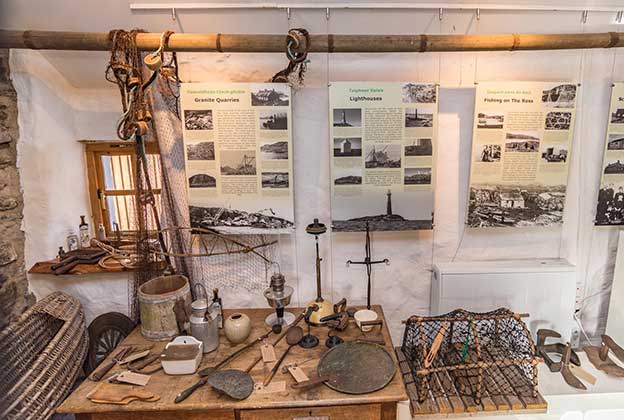
A Real Creel
romhc Sunday, 1 April 2018
A Real Creel
Among the artefacts in the Museum there’s now a creel – one that is different in several ways from those mass-produced and delivered in batches to the Bunessan and Fionnphort piers. Roger Harvey, fisherman and now both RoMHC Volunteer and Director, explained how he had made it, drawing on his interest in traditional skills, and his own experience of using creels: ‘When I started the only thing you could sell was lobsters. There was no market for velvet and brown crab.’ Traditionally the base would have used scrap wood – sturdy fish-boxes or orange boxes were ideal. Roger nailed the frame together; in the past hazel pegs might have been used instead of nails. The wooden hoops or bows were usually made of hazel, too, though Roger used willow from the garden of the Centre. This creel has a shape that’s traditional on this coast. Making them was a job for early spring, before the fishing season began. The wood would be cut when the sap was rising because then it’s more pliable. When the bows have been bent and fixed in place, a flat stone needs to be found and tied down in the centre of the base, to weight it. Above this hangs a bait-swing (the usual bait was salt mackerel). Then, tensioned over the bows, the net is knotted using a well-worn needle – in the past fishermen would have made those too, from wood. The eyes (entrance holes for the catch) which Roger incorporated were circles of fencing wire – originally they would have been hazel bound into a loop. Nowadays creels have a lot of metal, plastic and nylon in them. Roger says ‘The old boys didn’t like the metal creels saying they “sang underwater”, – on the other hand they lasted. You’d be replacing the wooden ones all the time.’ Creels used to be tarred after making, to preserve them as long as possible. This was a very messy job. Roger bought twine for the netting. Traditionally it would have been linen twine, which was also used for the salmon nets (like the one hanging in the Centre). Flax was grown on Mull until just after the second world war. The flax fibre is called guttihunk – which is not necessarily a word originating in Mull. Knitting it is a skill: ‘The whole creel takes shape and stability, as every bit is tensioned against everything else.’ says Roger, ‘It’s a very therapeutic job sitting and knitting a net. From beginning to end it took me four hours, but a skilled worker could make a creel in two. It is a simple thing – and they have been the same for hundreds of years. You know, they found the remnants of a creel at Skara Brae.’ Jan S. Pickard



